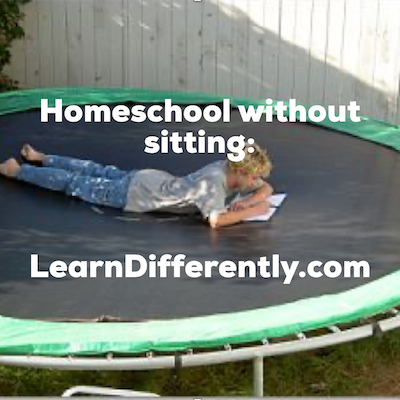Homeschool without sitting (much)

By Kathy Kuhl How do I get my children to sit and work?
(Part 4 of the Coronavirus Homeschool Survival Guide. The series begins here. For the post on why kids can’t sit still and how to help, click here.)
It’s difficult for many parents–both experienced homeschoolers and parents helping children with homework. Especially with the stresses we discussed last time, families struggle. Whether you assigned the work or a teacher did, you have a problem: How do I get them to settle down and work?

I’ve interviewed dozens of parents homeschooling students with attention deficit disorder. Before that, I homeschooled one highly distractible student for nine years. What helps our kids can help anyone.
Flexible seating
To begin, ask yourself, “Do they really need to sit down for this work?” Back in schools, the faculty is trying to educate hundreds of students at once. So they need uniform, efficient solutions. You probably experienced those school chairs—and not fondly.
But at home, you have more choices. Remember, for some people it’s not “sit and work.” It’s “sit or work.” Some of us work better if we don’t sit.
You can change seating many ways
Your kids can:
- Sit on an exercise ball.
- Sit on a inflatable cushion or one-legged stool. [Link below]
- Work on the floor. Lying on their stomachs provides deep pressure, which many find soothing. One mom told me her son liked to slide into a gap between his mattress and trundle bed! Under our dinner table, my son completed much of his fifth grade math, lying on his stomach.
- For even more deep pressure, another homeschooled boy liked to slide into the gap between his mattress and trundle bed! (All this deep pressure talk will remind some of you of the relaxing squeeze chute Dr. Temple Grandin constructed for herself while a teen. [LINK below.])
- One year when a homeschooled niece was a child, she completed lots of math standing at the kitchen table. Her mom reported she was often bouncing. (Well, how do you activate your little gray cells?)
Bouncing while learning
Speaking of bouncing, two parents I interviewed described how their children learned while on the trampoline. One in Long Island, New York, explained:
It doesn’t matter if she’s bouncing on the trampoline in the middle of winter [in Long Island, New York] while you’re shouting words from the kitchen. As long as she’s shouting the words back, you’re good. Her spelling has improved seven grade levels since she left public school [three years ago]. So, who cares if she’s bouncing on the trampoline! *
 Read a while, bounce a while. Photo courtesy Jeannie Parker.
Read a while, bounce a while. Photo courtesy Jeannie Parker.
Across the continent, a mom in Alberta told me that her son likes to do his work while lying on their trampoline in the backyard. When he gets restless, he jumps a while and then settles back down to work.
Floating homeschool—in a house or apartment
Along with changing where your child or teen sits, remember you can change locations at home throughout the day. Years ago, a Virginian mother told me, “My husband said, ‘You must not be homeschooling anymore. I never see you at the kitchen table.’ Now we homeschool on recliners, on the couch, on the bed, on the rug, in the backyard, in the gazebo.”*
Don’t have a gazebo? Perhaps you’re in an apartment. Moving about still helps with focus, and it’s healthy, too.
Read aloud on the sofa or on a bed. Build a blanket tent and read under it. As you read about explorers, pretend you’re camping under the stars, as everyone stretches out on the floor.
Think outside the classroom
Then look out the window. Let children learning to read see how many things starting with the sound “b” they can see from the window: brick, bird, boxes, and so on. Can older children calculate how many bricks cover a certain area, without counting: between window, perhaps?
Or have the kids put on swimsuits and sit in the tub to learn about volume by pouring from and comparing measuring cups. Let them build boats of different materials and see what floats best. Ask them and get them to think about why. Don’t explain too fast. Let them explore.
As I interviewed homeschoolers, many reported that their advice to new homeschoolers would be to overcome the school mentality—thinking homeschooling had to be just like school. (Some homeschoolers call this approach school-at-home.)*
Just because we’re homebound doesn’t mean we need to be bound by notions of how school should be at home.
For more help
*The quotations above are from chapters 6 (“Attitudes and Assumptions”) and 16 (“Starting Up Your Homeschool”) of Homeschooling Your Struggling Learner. It’s available on Amazon.
Extensively researched, carefully documented, and well organized, Homeschooling Your Struggling Learner is a veritable treasure trove of up-to-the-minute information, guidelines, and suggestions for helping children who flounder in traditional academic settings. Don’t be fooled by the title: anyone who lives or works with a struggling learner—parent, educator, or mental health professional—will find many a valuable nugget to aid in their work with these children.
~Barbara D. Ingersoll, Ph.D., author of Your Hyperactive Child.
If you have suggestions, I’d love to hear them. Please enter in the comments below. Thanks.
Other resources
One-legged stool, inflatable seat cushion and more sensory tools are on Amazon and also available from Abilitations.
After watching cattle relax under the pressure of a squeeze chute at her aunt’s ranch, young Temple Grandin built a squeeze chute (or hug machine) for herself. As Wikipedia explains, she would seek deep pressure, but found hugs from other people overstimulating.

